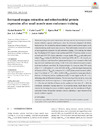Identificador persistente para citar o vincular este elemento:
https://accedacris.ulpgc.es/jspui/handle/10553/75553
| Campo DC | Valor | idioma |
|---|---|---|
| dc.contributor.author | Skattebo, Øyvind | en_US |
| dc.contributor.author | Capelli, Carlo | en_US |
| dc.contributor.author | Rud, Bjarne | en_US |
| dc.contributor.author | Auensen, Marius | en_US |
| dc.contributor.author | Calbet, Jose A.L. | en_US |
| dc.contributor.author | Hallén, Jostein | en_US |
| dc.date.accessioned | 2020-11-16T11:08:28Z | - |
| dc.date.available | 2020-11-16T11:08:28Z | - |
| dc.date.issued | 2020 | en_US |
| dc.identifier.issn | 0905-7188 | en_US |
| dc.identifier.other | Scopus | - |
| dc.identifier.uri | https://accedacris.ulpgc.es/handle/10553/75553 | - |
| dc.description.abstract | When exercising with a small muscle mass, the mass-specific O2 delivery exceeds the muscle oxidative capacity resulting in a lower O2 extraction compared with whole-body exercise. We elevated the muscle oxidative capacity and tested its impact on O2 extraction during small muscle mass exercise. Nine individuals conducted six weeks of one-legged knee extension (1L-KE) endurance training. After training, the trained leg (TL) displayed 45% higher citrate synthase and COX-IV protein content in vastus lateralis and 15%-22% higher pulmonary oxygen uptake ((Formula presented.)) and peak power output ((Formula presented.)) during 1L-KE than the control leg (CON; all P <.05). Leg O2 extraction (catheters) and blood flow (ultrasound Doppler) were measured while both legs exercised simultaneously during 2L-KE at the same submaximal power outputs (real-time feedback-controlled). TL displayed higher O2 extraction than CON (main effect: 1.7 ± 1.6% points; P =.010; 40%-83% of (Formula presented.)) with the largest between-leg difference at 83% of (Formula presented.) (O2 extraction: 3.2 ± 2.2% points; arteriovenous O2 difference: 7.1 ± 4.8 mL· L−1; P <.001). At 83% of (Formula presented.), muscle O2 conductance (DMO2; Fick law of diffusion) and the equilibration index Y were higher in TL (P <.01), indicating reduced diffusion limitations. The between-leg difference in O2 extraction correlated with the between-leg ratio of citrate synthase and COX-IV (r =.72-.73; P =.03), but not with the difference in the capillary-to-fiber ratio (P =.965). In conclusion, endurance training improves O2 extraction during small muscle mass exercise by elevating the muscle oxidative capacity and the recruitment of DMO2, especially evident during high-intensity exercise exploiting a larger fraction of the muscle oxidative capacity. | en_US |
| dc.language | eng | en_US |
| dc.relation.ispartof | Scandinavian Journal of Medicine and Science in Sports | en_US |
| dc.source | Scandinavian Journal of Medicine and Science in Sports[ISSN 0905-7188], v. 30(9), p. 1615-1631, (Septiembre 2020) | en_US |
| dc.subject | 241106 Fisiología del ejercicio | en_US |
| dc.subject.other | Arteriovenous Oxygen Difference | en_US |
| dc.subject.other | Blood Flow | en_US |
| dc.subject.other | Endurance Training | en_US |
| dc.subject.other | Fick Method | en_US |
| dc.subject.other | Limitations | en_US |
| dc.subject.other | Maximal Oxygen Uptake | en_US |
| dc.subject.other | Muscle Oxygen Diffusion | en_US |
| dc.subject.other | Peripheral Adaptations | en_US |
| dc.title | Increased oxygen extraction and mitochondrial protein expression after small muscle mass endurance training | en_US |
| dc.type | info:eu-repo/semantics/Article | en_US |
| dc.type | Article | en_US |
| dc.identifier.doi | 10.1111/sms.13707 | en_US |
| dc.identifier.scopus | 85085617755 | - |
| dc.contributor.authorscopusid | 56711333700 | - |
| dc.contributor.authorscopusid | 7004189630 | - |
| dc.contributor.authorscopusid | 25655368200 | - |
| dc.contributor.authorscopusid | 57215724697 | - |
| dc.contributor.authorscopusid | 7004323423 | - |
| dc.contributor.authorscopusid | 26656659300 | - |
| dc.identifier.eissn | 1600-0838 | - |
| dc.description.lastpage | 1631 | en_US |
| dc.description.firstpage | 1615 | en_US |
| dc.investigacion | Ciencias de la Salud | en_US |
| dc.type2 | Artículo | en_US |
| dc.description.numberofpages | 22 | en_US |
| dc.utils.revision | Sí | en_US |
| dc.identifier.ulpgc | Sí | en_US |
| dc.contributor.buulpgc | BU-FIS | en_US |
| dc.description.sjr | 1,575 | |
| dc.description.jcr | 4,221 | |
| dc.description.sjrq | Q1 | |
| dc.description.jcrq | Q1 | |
| dc.description.scie | SCIE | |
| item.fulltext | Con texto completo | - |
| item.grantfulltext | open | - |
| crisitem.author.dept | GIR IUIBS: Rendimiento humano, ejercicio físico y salud | - |
| crisitem.author.dept | IU de Investigaciones Biomédicas y Sanitarias | - |
| crisitem.author.dept | Departamento de Educación Física | - |
| crisitem.author.orcid | 0000-0002-9215-6234 | - |
| crisitem.author.parentorg | IU de Investigaciones Biomédicas y Sanitarias | - |
| crisitem.author.fullName | López Calbet, José Antonio | - |
| Colección: | Artículos | |
Citas SCOPUSTM
21
actualizado el 08-jun-2025
Citas de WEB OF SCIENCETM
Citations
22
actualizado el 08-jun-2025
Visitas
89
actualizado el 18-feb-2024
Descargas
372
actualizado el 18-feb-2024
Google ScholarTM
Verifica
Altmetric
Comparte
Exporta metadatos
Los elementos en ULPGC accedaCRIS están protegidos por derechos de autor con todos los derechos reservados, a menos que se indique lo contrario.
